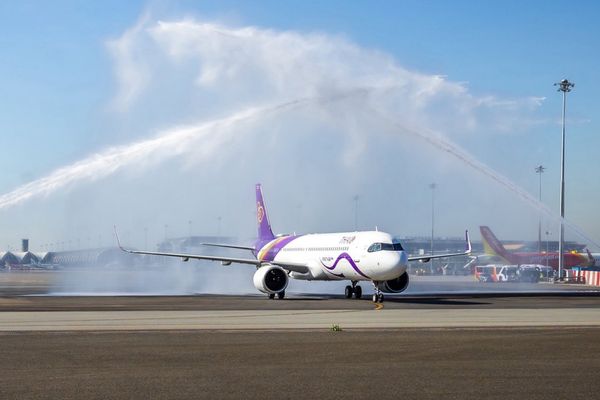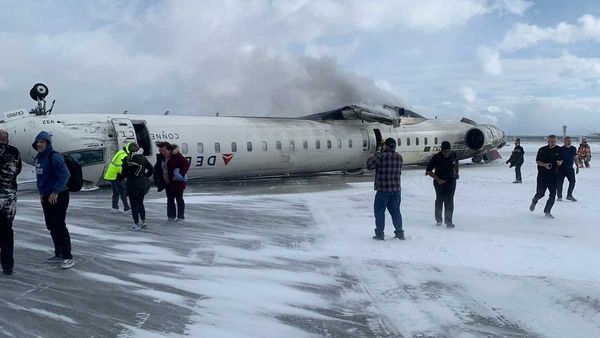Boeing has been experiencing high pressure and complications due to accidents and a lack of safety culture. Boeing CEO David Calhoun appeared in an interview with the New York Times in 2020. When asked to accept the blame for the fatal 737 MAX crashes, he avoided answering the question by stating whether U.S. pilots could have avoided them.
Crashes Involving the 737 MAX
Lion Air Flight 610
Lion Air Flight 610 (JT610/LNI610) was a domestic passenger flight operated with the Boeing 737 MAX departing from Soekarno-Hatta International Airport (CGK) and scheduled to land at Depati Amir Airport (PGK), Pangkal Pinang, Indonesia. On October 29, 2018, the aircraft crashed into the Java Sea just 13 minutes after takeoff. The accident resulted in the death of all 189 people on board and was the first major accident of the 737 MAX line.
The final report for the reason for the crash stated flaws in Boeing's plane design and errors by the airline and its staff. Pilots were never taught how to react promptly to the Boeing 737 MAX 8 jet's automated flight-control system malfunctions. The regulators have also criticized the design of MCAS; the system pushed the plane's nose down automatically, resulting in a challenging situation for the pilots fighting for control.
Ethiopian Airlines Flight 302
The operation was an international flight scheduled to depart from Bole International Airport (ADD) in Addis Ababa, Ethiopia, and landing at Jomo Kenyatta International Airport (NBO) in Nairobi, Kenya. On March 10, 2019, the Boeing 737 MAX 8 being utilized for the flight crashed near Bishoftu six minutes after takeoff. The impact took the lives of all 157 people on board.
This was the second MAX 8 accident less than five months after the Lion Air Flight 610 crash. The crashes resulted in a two-year worldwide long-term grounding of the jet and an investigation of how it was approved for passenger service. The reason was again the MCAS system, which caused a repetitive, automatic nose-down motion due to erroneous AOA (Air Operations Area). It resulted in the aircraft diving at the rate of -33,00ft/min close to the ground.
The CEO's Response
Calhoun succeeded Dennis Muilenberg as Boeing's chief executive in January 2020 after Muilenberg was fired from Boeing after various mistakes in managing the crises that resulted in the shutdown of the 737 factory and multiple investigations. Even though Calhoun, in the past, has come to the defense of how the former CEO handled the situation, he transformed his ideas about him and has criticized the way Muilenburg operated the company during 2020 and stated that the former CEO made some decisions that prioritized profit over quality.
He mentioned to the Times that:
"I'll never be able to judge what motivated Dennis, whether it was a stock price that was going to continue to go up and up, or whether it was just beating the other guy to the next rate increase."
At that time, Calhoun was eligible for a $7 million bonus dependent on his success in getting the 737 Max flying again.
However, at the beginning of 2024, an Alaska Airlines MAX 9 at about 16,000 feet over Oregon during an operation to California on January 5, made an emergency landing because the emergency door blew off, which raised many questions about Boeing's safety culture and put a lot of pressure again on the company and the CEO Calhoun.
On February 26, U.S. regulators released an assessment of Boeing's safety measurements and company culture, stating "a lack of awareness of safety-related metrics at all levels of the organization." The company was then assigned a 90-day deadline to develop an action plan addressing quality control. The Federal Aviation Administration (FAA) required the company to curate a structure to fix quality problems and meet safety standards for producing new planes less than two months after the Alaska Airlines incident.

FAA Administrator Mike Whitaker mentioned:
"Boeing must commit to real and profound improvements. Making foundational change will require a sustained effort from Boeing's leadership, and we are going to hold them accountable every step of the way, with mutually understood milestones and expectations."
The pressure kept increasing, and while Boeing considered purchasing its fuselage supplier Spirit AeroSystems to manage the production process more securely, the lawsuit came up. Three Alaska Airlines Flight 1812 passengers sued the airline and Boeing for $1 billion. The case stated negligence for allegedly ignoring the signs of an impending incident. The law firm said in a news release that it hopes "to hold Boeing accountable for its negligence which has caused extreme panic, fear, and post-traumatic stress."
As the incidents diversified and the ones in charge kept changing, the only thing left stable was the pressure. Even though the CEO position may have changed, Boeing's continuous errors kept occurring, creating an expected amount of pressure on the company.

USAir Flight 427: Another Incident Involving the Boeing 737 Family
The flight was scheduled from Chicago's O'Hare International Airport to Palm Beach International Airport, Florida, with a layover at Pittsburgh International Airport. On September 8, 1994, the Boeing 737 was utilized for the flight crash in Hopewell Township, Pennsylvania.
After a long investigation by the National Transportation Safety Board (NTSB), it was decided that the probable cause of the incident was that the aircraft's rudder (a primary control surface used to steer the plane is used to counter adverse yaw and p-factor and is not the primary control used to turn the aircraft) malfunctioned and went hard over to a direction opposite of what the pilots have determined the route as and the aircraft entered an aerodynamic stall, they were unable to recover. The impact killed all 132 people who were on board.
The official report, which took more than four and a half years to conclude, stated:
"The National Transportation Safety Board determined that the probable cause of the USAir Flight 427 accident was a loss of control of the airplane resulting from the movement of the rudder surface to its blowdown limit. The rudder surface most likely deflected in a direction opposite to that commanded by the pilots as a result of a jam of the main rudder power control unit servo valve secondary slide to the servo valve housing offset from its neutral position and overtravel of the primary slide."

At the start, the FAA did not agree with the statements and reported that "We believe, as much as we have studied this aircraft and this rudder system, that the actions we have taken assure a level of safety that is commensurate with any aircraft." They then changed their attitude about the situation after a special task force detected 46 potential failures and jams in the 737 rudder system that could result in a tragic event.
With its history of technical issues, Boeing continues to carry out the same amount of worries for its passengers. The power change in a company is to change an establishment's plans and structures to fix the existing issues. If Boeing comes up with other technical problems in the future, which can result in catastrophic events, the pressure will hardly go down.
Even though air transportation is safe, it can be easily untrusted due to these kinds of negligence. The safety culture of Boeing is not only affecting the company itself but also the future passengers' trust in aircraft and air transportation therefore shaking the industry.
“I’m Not Okay”: Chilling Audio Captures Near-Disaster as Pilot Tries to Kill Engines » How Drone Swarms Rewrote the Rules of Aviation » Final Delivery Tally and OEM Tracker »
Comments (0)
Add Your Comment
SHARE
TAGS
STORIES Boeing Crash Investigation 737 MAX Boeing 737 MAX Government Lion Air Ethiopian Airlines ControversyRECENTLY PUBLISHED
 Thai Airways Welcomes First Airbus A321neo
Thai Airways International (THAI) has officially ushered in a new chapter for its regional operations with the delivery of its first Airbus A321neo. The aircraft, registered as HS-TOA and christened with the royal name "Bowonrangsi," touched down at Bangkok Suvarnabhumi Airport (BKK) following a delivery flight from Hamburg via Dubai in late December 2025.
ROUTES
READ MORE »
Thai Airways Welcomes First Airbus A321neo
Thai Airways International (THAI) has officially ushered in a new chapter for its regional operations with the delivery of its first Airbus A321neo. The aircraft, registered as HS-TOA and christened with the royal name "Bowonrangsi," touched down at Bangkok Suvarnabhumi Airport (BKK) following a delivery flight from Hamburg via Dubai in late December 2025.
ROUTES
READ MORE »
 2025: Aviation Deaths are Down 27.3%, But Things Didn't Feel Safer
At first glance, the numbers for the year just passed are a triumph of engineering and oversight: total recorded incidents dropped by nearly 10%, and fatal accidents decreased by over 11%. However, beneath these encouraging drops in the death toll lies a statistic that should give every regulator pause: injuries are up.
STORIES
READ MORE »
2025: Aviation Deaths are Down 27.3%, But Things Didn't Feel Safer
At first glance, the numbers for the year just passed are a triumph of engineering and oversight: total recorded incidents dropped by nearly 10%, and fatal accidents decreased by over 11%. However, beneath these encouraging drops in the death toll lies a statistic that should give every regulator pause: injuries are up.
STORIES
READ MORE »
 Emirates A380 Makes Emergency Return to London Heathrow After New Year’s Eve Gear Failure
A high-capacity Emirates Airbus A380-800 was forced to make a precautionary return to London Heathrow Airport (LHR) on the afternoon of December 31, 2025, after encountering a technical malfunction with its landing gear system shortly after departure.
NEWS
READ MORE »
Emirates A380 Makes Emergency Return to London Heathrow After New Year’s Eve Gear Failure
A high-capacity Emirates Airbus A380-800 was forced to make a precautionary return to London Heathrow Airport (LHR) on the afternoon of December 31, 2025, after encountering a technical malfunction with its landing gear system shortly after departure.
NEWS
READ MORE »



